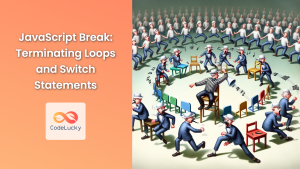In the world of C++ programming, control flow is king. One of the most powerful tools in a developer's arsenal for managing control flow is the break statement. This keyword allows you to exit a loop prematurely, giving you fine-grained control over your program's execution. In this comprehensive guide, we'll dive deep into the break statement, exploring its uses, best practices, and potential pitfalls.
Understanding the Break Statement
The break statement is a jump statement in C++ that terminates the smallest enclosing loop (do, for, or while) or switch statement. When encountered, it causes the program to exit the current loop or switch statement immediately and continue execution at the next statement following the loop or switch.
🔑 Key Point: The break statement affects only the innermost loop or switch statement in which it appears.
Let's start with a simple example to illustrate how break works:
#include <iostream>
int main() {
for (int i = 0; i < 10; i++) {
if (i == 5) {
break;
}
std::cout << i << " ";
}
std::cout << "\nLoop ended.";
return 0;
}
Output:
0 1 2 3 4
Loop ended.
In this example, the loop is set to run 10 times, but the break statement causes it to exit when i reaches 5.
Break in Different Loop Types
The break statement works similarly in all types of loops. Let's examine its behavior in while and do-while loops.
Break in While Loops
#include <iostream>
int main() {
int count = 0;
while (true) {
if (count == 5) {
break;
}
std::cout << count << " ";
count++;
}
std::cout << "\nWhile loop ended.";
return 0;
}
Output:
0 1 2 3 4
While loop ended.
Break in Do-While Loops
#include <iostream>
int main() {
int count = 0;
do {
if (count == 5) {
break;
}
std::cout << count << " ";
count++;
} while (true);
std::cout << "\nDo-while loop ended.";
return 0;
}
Output:
0 1 2 3 4
Do-while loop ended.
🔍 Note: In both cases, the loop would run indefinitely without the break statement.
Break in Nested Loops
When dealing with nested loops, break only exits the innermost loop. Let's see this in action:
#include <iostream>
int main() {
for (int i = 0; i < 3; i++) {
std::cout << "Outer loop iteration " << i << ":\n";
for (int j = 0; j < 5; j++) {
if (j == 3) {
break;
}
std::cout << " Inner loop: " << j << "\n";
}
}
return 0;
}
Output:
Outer loop iteration 0:
Inner loop: 0
Inner loop: 1
Inner loop: 2
Outer loop iteration 1:
Inner loop: 0
Inner loop: 1
Inner loop: 2
Outer loop iteration 2:
Inner loop: 0
Inner loop: 1
Inner loop: 2
As you can see, the break statement only affects the inner loop, causing it to terminate when j reaches 3. The outer loop continues to run for all three iterations.
Break in Switch Statements
While not a loop, the switch statement is another control structure where break plays a crucial role. Without break, execution "falls through" to the next case:
#include <iostream>
int main() {
int choice = 2;
switch (choice) {
case 1:
std::cout << "You chose 1\n";
break;
case 2:
std::cout << "You chose 2\n";
// No break here
case 3:
std::cout << "You chose 3\n";
break;
default:
std::cout << "Invalid choice\n";
}
return 0;
}
Output:
You chose 2
You chose 3
In this example, because there's no break after case 2, execution continues into case 3.
Practical Applications of Break
Now that we understand how break works, let's explore some practical applications.
1. Early Exit from Loops
One common use of break is to exit a loop early when a certain condition is met. This can be particularly useful when searching for a specific element in an array:
#include <iostream>
#include <vector>
int main() {
std::vector<int> numbers = {1, 3, 5, 7, 9, 11, 13, 15};
int target = 9;
bool found = false;
for (int num : numbers) {
if (num == target) {
found = true;
break;
}
}
if (found) {
std::cout << "Target found!";
} else {
std::cout << "Target not found.";
}
return 0;
}
Output:
Target found!
This approach is more efficient than checking every element, especially for large datasets.
2. Input Validation
break can be useful in input validation loops:
#include <iostream>
int main() {
int input;
while (true) {
std::cout << "Enter a number between 1 and 10: ";
std::cin >> input;
if (input >= 1 && input <= 10) {
break;
}
std::cout << "Invalid input. Try again.\n";
}
std::cout << "You entered: " << input;
return 0;
}
This loop continues until the user provides valid input.
3. Menu Systems
break is often used in menu-driven programs:
#include <iostream>
int main() {
int choice;
while (true) {
std::cout << "\n1. Option 1\n2. Option 2\n3. Exit\nEnter your choice: ";
std::cin >> choice;
switch (choice) {
case 1:
std::cout << "You chose Option 1\n";
break;
case 2:
std::cout << "You chose Option 2\n";
break;
case 3:
std::cout << "Exiting...\n";
return 0;
default:
std::cout << "Invalid choice. Try again.\n";
}
}
return 0;
}
This program runs until the user chooses to exit.
Best Practices and Considerations
While break is a powerful tool, it should be used judiciously. Here are some best practices and considerations:
-
🚦 Use with Caution: Overuse of
breakcan make code harder to read and maintain. Use it when it genuinely simplifies your logic. -
📝 Document Your Breaks: If you're using
breakin a complex or non-obvious way, add a comment explaining why. -
🔄 Consider Alternatives: Sometimes, restructuring your loop condition or using a flag variable can be clearer than using
break. -
🎯 Be Mindful in Nested Loops: Remember that
breakonly exits the innermost loop. If you need to exit multiple levels, you might need to use other techniques. -
🔍 Debug Carefully: When debugging loops with
breakstatements, pay extra attention to ensure they're triggering under the correct conditions.
Advanced Break Techniques
For more complex scenarios, you might need more sophisticated techniques. Here are a couple of advanced uses of break:
Breaking Out of Multiple Nested Loops
Sometimes, you might want to break out of multiple nested loops at once. While break itself can't do this directly, you can combine it with other control flow techniques:
#include <iostream>
int main() {
bool should_break = false;
for (int i = 0; i < 3 && !should_break; i++) {
for (int j = 0; j < 3 && !should_break; j++) {
for (int k = 0; k < 3; k++) {
std::cout << i << j << k << " ";
if (i == 1 && j == 1 && k == 1) {
should_break = true;
break;
}
}
if (should_break) break;
}
if (should_break) break;
}
std::cout << "\nLoops ended.";
return 0;
}
Output:
000 001 002 010 011 012 020 021 022 100 101 102 110 111
Loops ended.
This technique uses a flag variable to break out of all three loops when a specific condition is met.
Using Break with Lambdas
In modern C++, you can use lambdas with break to create more flexible loop exit conditions:
#include <iostream>
#include <vector>
#include <algorithm>
int main() {
std::vector<int> numbers = {1, 3, 5, 7, 9, 11, 13, 15};
int sum = 0;
std::for_each(numbers.begin(), numbers.end(), [&sum](int n) {
if (sum > 20) return;
sum += n;
std::cout << "Current sum: " << sum << "\n";
});
std::cout << "Final sum: " << sum;
return 0;
}
Output:
Current sum: 1
Current sum: 4
Current sum: 9
Current sum: 16
Current sum: 25
Final sum: 25
While this example doesn't use break explicitly, the early return in the lambda serves a similar purpose, stopping the iteration when the sum exceeds 20.
Common Pitfalls and How to Avoid Them
While break is a useful tool, it can lead to some common mistakes. Let's explore these pitfalls and how to avoid them:
1. Infinite Loops
One common mistake is forgetting to include a break condition in a while(true) loop:
#include <iostream>
int main() {
int i = 0;
while (true) {
std::cout << i << " ";
i++;
// Oops! We forgot to add a break condition
}
return 0;
}
This will result in an infinite loop. To fix this, always ensure you have a way to exit the loop:
#include <iostream>
int main() {
int i = 0;
while (true) {
std::cout << i << " ";
i++;
if (i >= 10) break; // Exit condition added
}
return 0;
}
2. Breaking Out of the Wrong Loop
In nested loops, it's easy to accidentally break out of the wrong loop:
#include <iostream>
int main() {
for (int i = 0; i < 3; i++) {
for (int j = 0; j < 3; j++) {
if (i == 1 && j == 1) {
break; // This only breaks the inner loop
}
std::cout << i << j << " ";
}
}
return 0;
}
Output:
00 01 02 10 20 21 22
If you intended to break out of both loops, you'd need to use a flag variable or goto statement (though goto is generally discouraged).
3. Forgetting Break in Switch Statements
Forgetting to include break in switch statements can lead to unexpected behavior:
#include <iostream>
int main() {
int choice = 2;
switch (choice) {
case 1:
std::cout << "One";
case 2:
std::cout << "Two";
case 3:
std::cout << "Three";
default:
std::cout << "Default";
}
return 0;
}
Output:
TwoThreeDefault
To fix this, add break statements:
#include <iostream>
int main() {
int choice = 2;
switch (choice) {
case 1:
std::cout << "One";
break;
case 2:
std::cout << "Two";
break;
case 3:
std::cout << "Three";
break;
default:
std::cout << "Default";
}
return 0;
}
Output:
Two
Performance Considerations
While break is a simple and effective way to exit loops early, it's worth considering its performance implications in certain scenarios.
Break vs. Condition in Loop Header
In most cases, using break won't have a significant performance impact compared to putting the condition in the loop header. However, for very tight loops that are executed frequently, there might be a slight difference:
#include <iostream>
#include <chrono>
int main() {
const int ITERATIONS = 1000000000;
// Using break
auto start = std::chrono::high_resolution_clock::now();
for (int i = 0; i < ITERATIONS; i++) {
if (i >= ITERATIONS / 2) break;
}
auto end = std::chrono::high_resolution_clock::now();
std::chrono::duration<double> diff = end - start;
std::cout << "Time with break: " << diff.count() << " s\n";
// Using condition in loop header
start = std::chrono::high_resolution_clock::now();
for (int i = 0; i < ITERATIONS / 2; i++) {
// Loop body
}
end = std::chrono::high_resolution_clock::now();
diff = end - start;
std::cout << "Time with condition in header: " << diff.count() << " s\n";
return 0;
}
The performance difference is usually negligible, and readability should be the primary concern.
Break in Large Data Sets
When working with large data sets, using break to exit early can significantly improve performance:
#include <iostream>
#include <vector>
#include <chrono>
#include <algorithm>
int main() {
std::vector<int> largeDataSet(10000000);
std::fill(largeDataSet.begin(), largeDataSet.end(), 1);
largeDataSet[9999999] = 2; // Target element at the end
// Without break
auto start = std::chrono::high_resolution_clock::now();
for (int num : largeDataSet) {
if (num == 2) {
// Found it, but keep going
}
}
auto end = std::chrono::high_resolution_clock::now();
std::chrono::duration<double> diff = end - start;
std::cout << "Time without break: " << diff.count() << " s\n";
// With break
start = std::chrono::high_resolution_clock::now();
for (int num : largeDataSet) {
if (num == 2) {
break; // Exit as soon as we find it
}
}
end = std::chrono::high_resolution_clock::now();
diff = end - start;
std::cout << "Time with break: " << diff.count() << " s\n";
return 0;
}
In this case, using break can lead to significant performance improvements, especially when the target element is found early in the data set.
Conclusion
The break statement is a powerful tool in C++ that allows for more flexible and efficient control flow in loops and switch statements. When used judiciously, it can simplify code and improve performance. However, it's important to use break thoughtfully and be aware of potential pitfalls.
Remember these key points:
- 🔑
breakexits only the innermost loop or switch statement. - 🚦 Use
breakwhen it genuinely simplifies your logic. - 📝 Document non-obvious uses of
break. - 🔄 Consider alternatives like restructuring loop conditions when appropriate.
- 🎯 Be extra careful with
breakin nested loops. - 🔍 Pay close attention to
breakconditions when debugging.
By mastering the use of break, you'll be able to write more efficient and readable C++ code. Happy coding!













